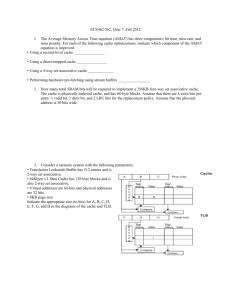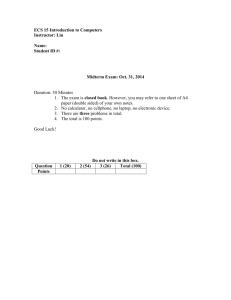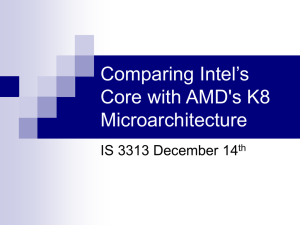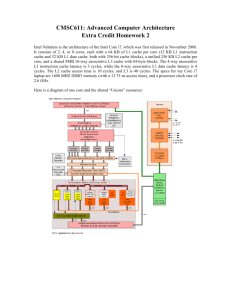2-Level Page Tables
advertisement
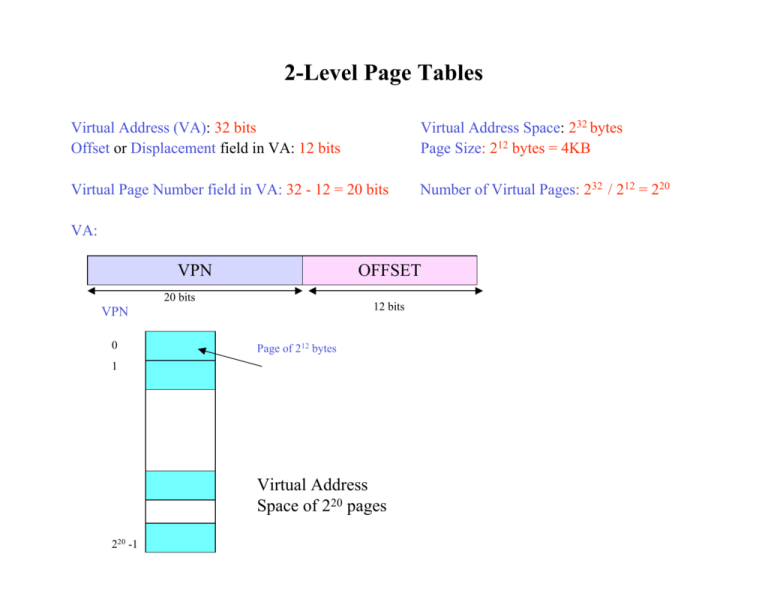
2-Level Page Tables Virtual Address (VA): 32 bits Offset or Displacement field in VA: 12 bits Virtual Address Space: 232 bytes Page Size: 212 bytes = 4KB Virtual Page Number field in VA: 32 - 12 = 20 bits Number of Virtual Pages: 232 / 212 = 220 VA: VPN OFFSET 20 bits 12 bits VPN 0 Page of 212 bytes 1 Virtual Address Space of 220 pages 220 -1 2-Level Page Tables PA: Physical Address (PA): 38 bits Offset or Displacement field in PA: 12 bits Physical Address Space: 238 bytes Page Size: 212 bytes = 4KB Page Frame Number field in PA: 38 - 12 = 26 bits Number of Physical Pages: 238 / 212 = 226 PFN 26 bits 0 OFFSET 12 bits Page Frame of size 212 bytes 1 Physical Address Space of 226 pages 226 -1 1 BYTE 0 1 BYTE 0 1 0 1 1 220 -1 220 -1 Page Table: 220 descriptors 1 descriptor for each Virtual Page VPN can be used as an index into Page Table to find the descriptor for that page Single Level Page Table 226 -1 • Descriptor holds the Page Frame Number (PFN) of the virtual page if it is in memory • • A presence bit (P) indicates if it is in memory or on the backing device Descriptor also contains other administrative and protection bits – e.g. D (Dirty), U (Used), R (Read), W (Write), E(Execute) etc. In the example: PFN requires 26 bits Assume exactly the 6 administrative bits mentioned above Descriptor is 26+6 = 32 bits or 4 bytes wide. Size of Page Table = Number of descriptors x Size of descriptor = 220 x 4 bytes = 4MB Two-Level Page Tables • Break up Page Table into fixed-size blocks of the same size as a page • In example: Each page is 4KB and Page Table is 4MB • So we will have 4MB/4KB = 210 = 1024 such blocks – This collection of blocks that make up the Page Table will be called the 2nd-level Page Table – The 1st-Level Page Table will have entries pointing to each block of the 2nd level Page Table. – In example: 1024 entries in the 1st-level Page Table • How many descriptors in each block? – Each block (or page of the Page Table) will hold: 4KB/4bytes = 1024 descriptors 210 entries: one for each block of 2nd level page table 2nd-Level Page Table 0 1 210 Descriptors per block (page) of the Page Table 1st-Level Page Table 220 -1 210 such blocks (pages) of the Page Table Page Table: 220 descriptors 1 descriptor for each Virtual Page Blocked into 210 blocks of 210 descriptors each 210 entries: one for each block of 2nd level page table 2nd-Level Page Table 0 1 210 Descriptors per block (page) of the Page Table 1st-Level Page Table 220 -1 210 such blocks (pages) of the Page Table Do not need to store the entire 2nd level Page Table as a contiguous array Do not allocate blocks that have no descriptors Keep blocks on secondary store and bring in when needed (mini virtual memory system for the Page Table management) 210 entries: one for each block of 2nd level page table 2nd-Level Page Table 0 210 Descriptors per block (page) of the Page Table 1st-Level Page Table 220 -1 Do not need to store the entire 2nd level Page Table as a contiguous array Do not allocate blocks that have no descriptors Keep blocks on secondary store and bring in when needed (mini virtual memory system for the Page Table management) Q: What is the actual size of virtual address space being used by the above process? Each descriptor represents to a 212 = 4KB portion of the address space 2 blocks = 2 x 1024 descriptors imply : 2 x 1024 x 4KB = 8MB address space Virtual Memory: 2-level Page Table 10 MSBs (bits 22..31) of the virtual address (PTN) are used to index into the Page Table Directory Next 10 bits (12 ..21) are used to index the chosen Page Table. PTN (10) PN(10) PD(12) 0 1 2 Page Offset (PD) 1023 PTR 0 1 0 2 1 2 1023 4KB Page 0 1 1022 1023 1st-Level Page Table (Page Table Directory) 2 1023 Page Tables More Details on Page Table Lookup 26 bits PTN (10) PTR PTR 26 PTN 10 PN(10) PD(12) 00 2 38 bit physical address of desired1st-level Page Table entry 1st Level Page Table and all blocks of the 2nd-level Page Table are stored at Page Aligned Boundaries i.e. 12 LSBs are zero More Details on Page Table Lookup 26 bits PTN (10) Base Address PN(10) PD(12) From selected entry in 1st-level PT Base Address 26 PN 10 00 2 38 bit physical address of desired 2nd-level Page Table entry More Details on Page Table Lookup 26 bits PTN (10) PFN PN(10) PD(12) From selected entry in 2nd-level PT PFN 26 PD 12 38 bit physical address of desired memory byte Virtual Memory and Caches Physical cache Accessed using translated physical address Cache access only after TLB translation Common case (cache hit) slowed down Cache locations addressed using physical memory addresses Physical Address (PA) TAG CPU VPN VA PA TLB PAGE OFFSET C ACHE INDEX BYTE OFFSET PHYSICAL CACHE PFN Virtual Address (VA) Can we avoid latency of translation every memory access? PAGE OFFSET Physical Address (PA) Virtual Memory and Caches Virtual cache Accessed using the virtual address directly VPN PAGE OFFSET Virtual Address (VA) TLB CPU PA VA PFN VIRTUAL CACHE Virtual Address (VA) TAG C ACHE INDEX BYTE OFFSET PAGE OFFSET Physical Address (PA) Cache locations addressed using virtual memory addresses Virtual Memory and Caches Virtual Cache Accessed using virtual addresses (+) Address translation (TLB lookup) in parallel with cache lookup Access TLB for protection information unless information replicated in cache (-) Context switch must invalidate all cache entries Every process has the same virtual address space 0 … 2n -1 How do you distinguish a virtual address of some process from the same virtual address of a different process ? Use processor identifiers (PIDs) as additional field to tag cache blocks Virtual Memory and Caches Virtual Cache VA = 011 0100 PA = 00 0100 Physical Memory VPN 0 PFN 1 VA = 011 1110 2 3 0 TAG 0 01101 4 5 PA = 00 1110 3 16 14 10101 6 01111 7 10111 Page Table Process 0 4 1 Virtual Cache Direct Mapped size 4 Blocks 2 Assumes cache block size of w bytes VA = 101 0101 PA = 11 0101 5 VA = 101 1111 PA = 11 1111 3 15 w BYTES Virtual Memory and Caches Virtual Cache VA = 011 0100 Physical Memory VPN 0 PFN 1 VA = 011 1110 2 3 0 0 01101 4 5 TAG 3 01111 7 10111 Page Table Process 0 1 Virtual Cache 4 14 5 0 2 1 2 1 15 VA = 101 0101 5 4 5 16 14 10101 6 3 4 2 VA = 101 1111 6 3 15 7 Page Table Process 1 Process 1 will access cached data of Process 0 Virtual Memory and Caches Virtual Cache Physical Memory VPN 0 PFN 1 2 3 0 4 5 3 6 7 Page Table Process 0 1 2 1 4 5 TAG I I I I 01101 2 6 7 Page Table Process 1 0 4 16 14 10101 01111 10111 1 Virtual Cache Solution 1: Invalidate all cache blocks on a context switch 0 3 V Cache blocks that may have survived (i.e were not evicted) by swapped-in process are wastefully invalidated. Cold cache on resumption 4 14 5 2 15 5 3 15 Virtual Memory and Caches Virtual Cache Physical Memory VPN 0 PFN 1 2 3 0 4 5 3 6 7 Page Table Process 0 0 1 2 3 1 PROCESS ID TAG 0 0 0 0 01101 0 5 6 16 14 10101 01111 10111 1 Virtual Cache Solution 2: Add a process id field as a part of the tag to identify the process whose blocks are in cache 4 14 5 2 15 5 4 2 4 3 15 7 Page Table Process 1 Virtual Memory and Caches Virtual Cache : Accessed using virtual addresses (-) Aliases: Different names for the same physical object Different virtual address but same physical address May result in multiple inconsistent copies of the data in the cache : Virtual Memory and Caches Virtual Cache Virtual Cache VPN TAG 0 1 000 2 001 3 0 011 5 100 0 7 0 1 101 1 01 110 Page Table Process 0 PFN 010 4 6 11 Physical Memory 2 111 3 VA: 011 01 VA: 110 01 PA: 00 01 PA: 00 01 Note: This can only happen if the number of blocks in any way of the cache is greater than the number of blocks in a virtual page. 2 cached copies of same physical location (in different cache locations) For aliasing to occur: The cache page size must exceed the virtual page size 4

